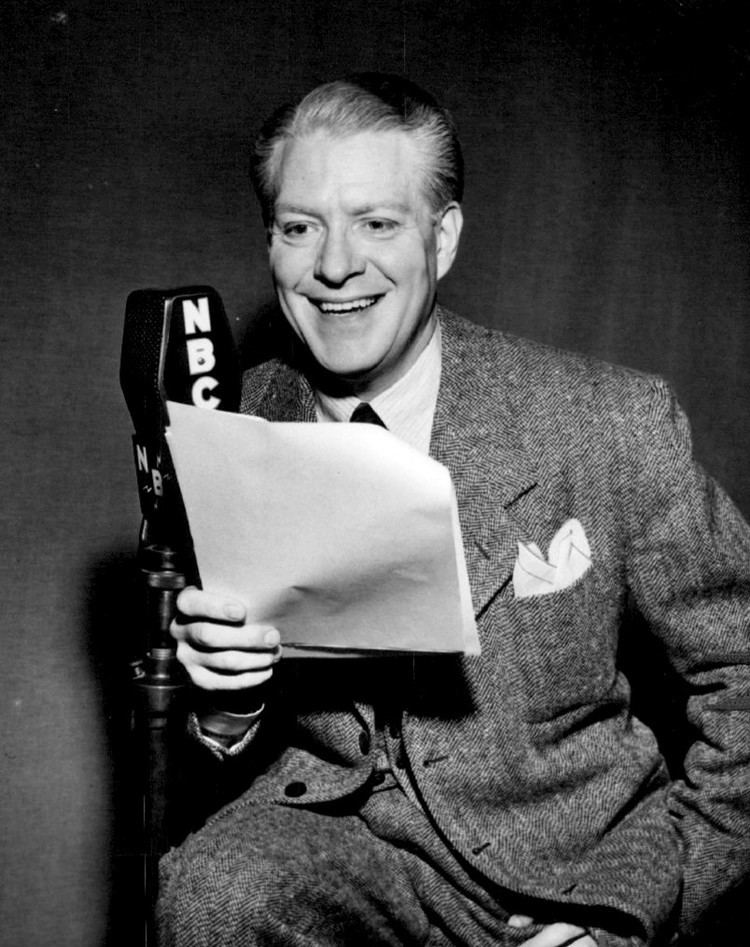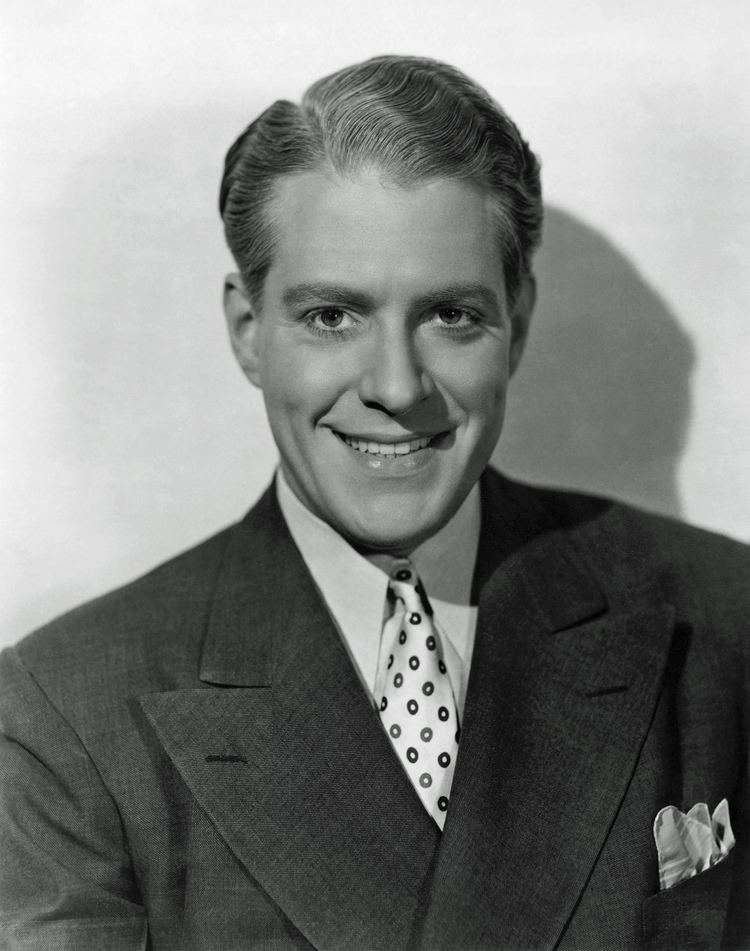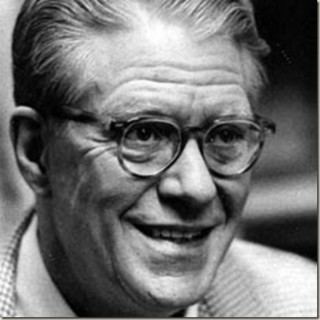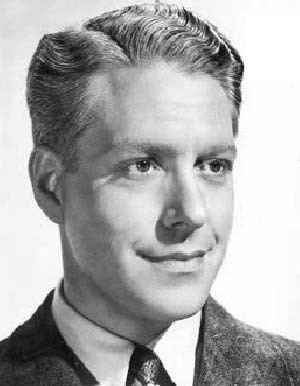Spouse Ann Denitz (m. 1939–1967) Role Singer | Name Nelson Eddy Occupation Baritone, film star | |
 | ||
Full Name Nelson Ackerman Eddy Died March 6, 1967, Palm Beach, Florida, United States Similar People | ||
Cause of death Cerebral hemorrage | ||
Dust to dust nelson eddy jeanette macdonald
Nelson Ackerman Eddy (June 29, 1901 – March 6, 1967) was an American singer and actor who appeared in 19 musical films during the 1930s and 1940s, as well as in opera and on the concert stage, radio, television, and in nightclubs. A classically trained baritone, he is best remembered for the eight films in which he costarred with soprano Jeanette MacDonald. He was one of the first "crossover" stars, a superstar appealing both to shrieking bobby soxers and opera purists, and in his heyday, he was the highest paid singer in the world.
Contents
- Dust to dust nelson eddy jeanette macdonald
- Jeanette macdonald nelson eddy sing pretty as a picture wmv
- Early life
- Singing
- Hollywood
- Recordings
- War work
- Radio and television
- Nightclub act
- Personal life
- EddyMacDonald romance
- Death
- Papers
- Discography
- References

During his 40-year career, he earned three stars on the Hollywood Walk of Fame (one each for film, recording, and radio), left his footprints in the wet concrete at Grauman's Chinese Theater, earned three gold records, and was invited to sing at the third inauguration of U.S. President Franklin D. Roosevelt in 1941. He also introduced millions of young Americans to classical music and inspired many of them to pursue a musical career.

Jeanette macdonald nelson eddy sing pretty as a picture wmv
Early life

Eddy was born in Providence, Rhode Island, the only child of Caroline Isabel (née Kendrick) and William Darius Eddy. His father was a machinist and toolmaker whose work required him to move from town to town. Nelson grew up in Providence and Pawtucket, Rhode Island, and in New Bedford, Massachusetts. As a boy, he was a redhead and quickly acquired the nickname "Bricktop". As an adult, his red hair was streaked with silver, so his hair photographed as blond. He came from a musical family. His Atlanta-born mother was a church soloist, and his grandmother, Caroline Netta Ackerman Kendrick, was a distinguished oratorio singer. His father occasionally moonlighted as a stagehand at the Providence Opera House, sang in the church choir, played the drums, and performed in local productions such as H.M.S. Pinafore. His parents divorced when he was 14.

Living in near poverty, Eddy was forced to drop out of school and moved with his mother to Philadelphia, where her brother, Clark Kendrick, lived. His uncle helped Eddy secure a clerical job at the Mott Iron Works, a plumbing supply company. He later worked as a reporter with the Philadelphia Press, the Evening Public Ledger, and the Philadelphia Evening Bulletin. He also worked briefly as a copywriter at N.W. Ayer Advertising, but was dismissed for constantly singing on the job. Eddy never returned to school, but educated himself with correspondence courses. He was bitter that his father refused to provide financial support after the divorce, but in later years they had an uneasy reconciliation.
Singing

Eddy developed his talent as a boy soprano in church choirs. Throughout his teens, Eddy studied voice and imitated the recordings of baritones such as Titta Ruffo, Antonio Scotti, Pasquale Amato, Giuseppe Campanari, and Reinald Werrenrath. He gave recitals for women's groups and appeared in society theatricals, usually for little or no pay.

Having had a job in an iron works factory, he then spent ten years as a newspaper reporter, but was fired for paying more attention to music than to journalism. His first professional break came in 1922, when he was singled out by the press after an appearance in a society theatrical, The Marriage Tax, although his name had been omitted from the program.

In 1924, Eddy won the top prize in a competition that included a chance to appear with the Philadelphia Opera Society. By the late 1920s, Eddy was appearing with the Philadelphia Civic Opera Company and had a repertoire of 28 operas, including Amonasro in Aida, Marcello in La bohème, Papageno in The Magic Flute, Almaviva in The Marriage of Figaro, both Tonio and Silvio in Pagliacci, and Wolfram in Tannhäuser.

Eddy performed in Gilbert and Sullivan operas with the Savoy Company, the oldest amateur theater company in the world devoted exclusively to the works of Gilbert and Sullivan in the traditional manner. With Savoy, Eddy sang the leading role of Strephon in Iolanthe at the Broad Street Theatre in Philadelphia in 1922. The next year, he played the role of Major-General Stanley in Savoy's production of The Pirates of Penzance. He reprised the role of Strephon with Savoy in 1927, when the theater group moved their performances to the famed Academy of Music. Thirty-one years later, he was asked by a Savoy lead playing the role of Strephon in 1958 for his thoughts and recommendations on how to play the role. Eddy wrote:
Eddy studied briefly with the noted teacher David Scull Bispham, a former Metropolitan Opera singer, but when Bispham died suddenly, Eddy became a student of William Vilonat. In 1927, Eddy borrowed some money and followed his teacher to Dresden for European study, which was then considered essential for serious American singers. He was offered a job with a small German opera company. Instead, he decided to return to America, where he concentrated on his concert career, making only occasional opera appearances during the next seven years. In 1928, his first concert accompanist was a young pianist named Theodore (Ted) Paxson, who became a close friend and remained his accompanist until Eddy's death 39 years later. In the early 1930s, Eddy's principal teacher was Edouard Lippé, who followed him to Hollywood and appeared in a small role in Eddy's 1935 film Naughty Marietta. In his later years, Eddy frequently changed teachers, constantly trying new vocal techniques. He also had a home recording studio, where he studied his own performances. It was his fascination with technology that inspired him to record three-part harmonies (tenor, baritone, & bass) for his role as a multiple-voiced singing whale in the animated Walt Disney feature, "The Whale Who Wanted to Sing at the Met", the concluding sequence in the 1946 feature film Make Mine Music.
With the Philadelphia Civic Opera, Eddy sang in the only American performance of Feuersnot by Richard Strauss (December 1, 1927) and in the first American performance of Strauss's Ariadne auf Naxos (November 1, 1928) with Helen Jepson. In Ariadne, Eddy sang the roles of the Wigmaker and Harlequin in the original German. He performed under Leopold Stokowski as the Drum Major in the second American performance of Alban Berg's Wozzeck on November 24, 1931.
At Carnegie Hall in New York City, Christmas 1931, he sang in the world premiere of Maria Egiziaca (Mary in Egypt), unexpectedly conducted by the composer Ottorino Respighi himself when famed conductor Arturo Toscanini fell ill at the last minute. Years later, when Toscanini visited the MGM lot in California, Eddy greeted him by singing a few bars of Maria Egiziaca.
Eddy continued in occasional opera roles until his film work made it difficult to schedule appearances the requisite year or two in advance. Among his final opera performances were three with the San Francisco Opera in 1934, when he was still "unknown". Marjory M. Fisher of the San Francisco News wrote of his December 8, 1934, performance of Wolfram in Tannhäuser, "Nelson Eddy made a tremendously fine impression ... he left no doubt in the minds of discerning auditors that he belongs in that fine group of baritones which includes Lawrence Tibbett, Richard Bonelli, and John Charles Thomas and which represents America's outstanding contribution to the contemporary opera stage." He also sang Amonasro in Aida on November 11, 1934 to similar acclaim. Elisabeth Rethberg, Giovanni Martinelli, and Ezio Pinza were in the cast. However, opera quietly faded from Eddy's schedule as films and highly lucrative concerts claimed more and more of his time.
When he resumed his concert career following his screen success, he made a point of delivering a traditional concert repertoire, performing his hit screen songs only as encores. He felt strongly that audiences needed to be exposed to all kinds of music.
Hollywood
Eddy was "discovered" by Hollywood when he substituted at the last minute for the noted diva, Lotte Lehmann, at a sold-out concert in Los Angeles on February 28, 1933. He scored a professional triumph with 18 curtain calls, and several film offers immediately followed. After much agonizing, he decided that being seen on screen might boost audiences for what he considered his "real work", his concerts. (Also, like his machinist father, he was fascinated with gadgets and the mechanics of the new talking pictures.) Eddy's concert fee rose from $500 to $10,000 per performance.
Eddy signed with Metro-Goldwyn-Mayer (MGM), where he made the first 15 of his 19 feature films. His contract guaranteed him three months off each year to continue his concert tours. MGM was not sure how to use him, and he spent more than a year on salary with little to do. His voice can be heard singing "Daisy Bell" on the soundtrack of the 1933 Pete Smith short, Handlebars. He appeared and sang one song each in Broadway to Hollywood and Dancing Lady, both in 1933, and Student Tour in 1934. Audience response was favorable, and he was cast as the male lead opposite the established star Jeanette MacDonald in a film version of Victor Herbert's 1910 operetta Naughty Marietta.
Naughty Marietta was the surprise hit of 1935. Its key song, "Ah! Sweet Mystery of Life", became a hit and earned Eddy his first gold record. He also sang "Tramp, Tramp, Tramp" and "I'm Falling in Love with Someone". The film was nominated for an Oscar as Best Picture, received the Photoplay Gold Medal Award as Best Picture, and was voted one of the Ten Best Pictures of 1935 by the New York film critics. Critics singled out Eddy for praise:
Eddy appeared in seven more MGM films with Jeanette MacDonald:
Nelson Eddy also starred in films with other leading ladies:
After Eddy and MacDonald left MGM in 1942, several unrealized films remained that would have reunited the team. Eddy signed with Universal in 1943 for a two-picture deal. The first was Phantom of the Opera and the second would have co-starred MacDonald. She filmed her two scenes for Follow the Boys, then both stars severed ties with Universal, as Eddy was upset with how Phantom of the Opera turned out.
Among their later other proposed projects were East Wind; Crescent Carnival, a book optioned by MacDonald; and The Rosary, the 1910 best-seller, which Eddy had read as a teen and pitched to MGM as a "comeback" film for MacDonald and himself in 1948. Under the name "Isaac Ackerman" he wrote a biopic screenplay about Chaliapin, in which he was to play the lead and also a young Nelson Eddy, but it was never produced. He also wrote two movie treatments for MacDonald and himself, Timothy Waits for Love and All Stars Don't Spangle.
Recordings
Eddy made more than 290 recordings between 1935 and 1964, singing songs from his films, plus opera, folk songs, popular songs, Gilbert and Sullivan, and traditional arias from his concert repertoire. Since both MacDonald and he were under contract to RCA Victor between 1935 and 1938, this allowed several popular duets from their films. In 1938, he signed with the Columbia Masterworks division of Columbia Records, which ended MacDonald-Eddy duets until Favorites in Stereo, a special LP album the two made together in 1959. He also recorded duets with his other screen partner Risë Stevens (The Chocolate Soldier) and for albums with, among others, Nadine Conner, Doretta Morrow, Eleanor Steber, and Jo Stafford.
Eddy's recordings drew rave reviews during the 1930s and 1940s, but he continued to rate them into the 1960s. The Los Angeles Herald-Examiner on October 4, 1964 noted: "Nelson Eddy continues to roll along, physically and vocally indestructible. Proof is his newest recording on the Everest label, "Of Girls I Sing". At the age of 63 and after 42 years of professional singing, Eddy demonstrates not much change has occurred in his romantic and robust baritone, which made him America's most popular singer in the early '30s".
War work
Like many performers, Eddy was active in "war work" during World War II, even before the United States entered the war. He did his first "war effort" concert on October 19, 1939, with Leopold Stokowski for Polish war relief. In 1942, he became an air raid warden and also put in long hours at the Hollywood Canteen. He also broadcast for the armed forces throughout the war. In late 1943, he went on a two-month, 35,000-mile tour, giving concerts for military personnel in Belém and Natal, Brazil; Accra, Gold Coast; Aden; Asmara, Eritrea; Cairo (where he met King Farouk); Tehran; Casablanca; and the Azores. He spoke fluent German and worked as a spy, but his cover was blown and he was injured while on assignment in Cairo.
Radio and television
Eddy began his more than 600 radio appearances in the mid-1920s. The first may have been on December 26, 1924 at station WOO in Philadelphia. Besides his many guest appearances, he hosted The Voice of Firestone (1936), The Chase and Sanborn Hour (1937–39), and Kraft Music Hall (1947–48), among other programs. He had his own show on CBS in 1942–43. Eddy frequently used his radio shows to advance the careers of promising young singers. While his programs often featured "serious" music, they were never straitlaced. It was in a series of comedy routines with Edgar Bergen and Charlie McCarthy on the Chase and Sanborn Hour that Eddy's name became associated with the song "Carry Me Back to Old Virginny", which was also included in the film Maytime. On March 31, 1933 he performed the role of Gurnemanz in a broadcast of Richard Wagner's opera Parsifal with Rose Bampton, conducted by Leopold Stokowski. During the 1940s, he was a frequent guest on Lux Radio Theater with Cecil B. DeMille, performing radio versions of Eddy's popular films. In 1951, Eddy guest-starred on several episodes of The Alan Young Show on CBS-TV. In 1952, he recorded a pilot for a sitcom, Nelson Eddy's Backyard, with Jan Clayton, but it failed to find a network slot. On November 12, 1952, he surprised his former co-star Jeanette MacDonald when she was the subject of Ralph Edwards' This Is Your Life. On November 30, 1952, Eddy was Ed Sullivan's guest on Toast of the Town.
During the next decade, he guest-starred on Danny Thomas's sitcom Make Room for Daddy and on variety programs such as The Ford Show, Starring Tennessee Ernie Ford, The Bob Hope Show, The Colgate Comedy Hour, The Spike Jones Show, The Dinah Shore Chevy Show, and The Big Record (with Patti Page). He was a frequent guest on talk shows, including The Merv Griffin Show and The Tonight Show with Jack Paar. On May 7, 1955, Eddy starred in Max Liebman's 90-minute, live-TV version of Sigmund Romberg's The Desert Song on NBC-TV. It featured Gale Sherwood, Metropolitan Opera bass Salvatore Baccaloni, veteran film actor Otto Kruger, and the dance team of Bambi Linn and Rod Alexander.
Nightclub act
The advent of television made inroads in the once-lucrative concert circuits, and in the early 1950s, Eddy had to consider future career options, eventually deciding to form a nightclub act, which premiered in January 1953 with singer Gale Sherwood, his partner, and Ted Paxson, his accompanist. Variety wrote, "Nelson Eddy, vet of films, concerts, and stage, required less than one minute to put a jam-packed audience in his hip pocket in one of the most explosive openings in this city's nightery history.... Before Eddy had even started to sing, they liked him personally as a warm human being". The act continued for the next 15 years and made four tours of Australia.
Personal life
Eddy married Ann Denitz Franklin, former wife of noted director Sidney Franklin, on January 19, 1939. Her son, Sidney Jr., became Eddy's stepson, but Nelson and she had no children of their own. They were married for 27 years, until Nelson's death. Ann Eddy never remarried after Nelson's death and died on August 28, 1987. She is buried next to Eddy and Eddy's mother in Hollywood Forever Cemetery.
Eddy/MacDonald romance
John Kenneth Hilliard, a sound engineer backstage at MGM from 1933 to 1942, reported in 1981 that though Nelson Eddy and Jeanette MacDonald were a screen couple, they "hated each other with a vengeance". Despite their ups and downs, an offscreen affair was verified by Jim Bayless, another MGM sound engineer from 1929 to 1942 who built Eddy's home recording equipment in 1934 and taught him how to record multitrack harmonies with himself; this resulted in Eddy recording a record album of four-part harmony. Bayless later left MGM to be vice president for newly formed Capitol Records, but remained friends with Eddy and for many years recorded Eddy's weekly radio shows on disc for him to critique. Other MGM staff who verified the relationship included their makeup artists William Tuttle and Fred Phillips and fellow singers Miliza Korjus and Rise Stevens.
Sweethearts by Sharon Rich, a biography first published in 1994 and updated and expanded in 2014, claims that MacDonald's marriage to Gene Raymond was engineered by studio boss Louis B. Mayer to prevent Eddy from marrying MacDonald. Rich's original source for this information was Jeanette MacDonald's older sister, actress Blossom Rock. The Eddy-MacDonald romance appears again in print in The Golden Girls of MGM by Jane Ellen Wayne. In these books, it is reported that Eddy's relationship with MacDonald began in late 1933 and continued, with a few breaks, until her death in 1965. Newsreel footage from MacDonald's funeral shows Eddy as the last person exiting the chapel, circled by other celebrities such as Lauritz Melchior who offer him condolences. Many of Eddy's personal letters and diary entries indicating a rocky romance with MacDonald were reproduced in Sweethearts.
Death
In March, 1967, Eddy was performing at the Sans Souci Hotel in Palm Beach, Florida when he was stricken on stage with a cerebral hemorrhage. His singing partner, Gale Sherwood, and his accompanist, Ted Paxson, were at his side. He died a few hours later in the early hours of March 6, 1967, at the age of 65. He is interred at Hollywood Forever Cemetery, between his mother and his widow (who outlived him by twenty years).
Papers
Eddy's meticulously annotated scores (some with his caricatures sketched in the margins) are now housed at Occidental College Music Library in Los Angeles. His personal papers and scrapbooks are at the University of Southern California Cinema/Television Library, also in Los Angeles.
